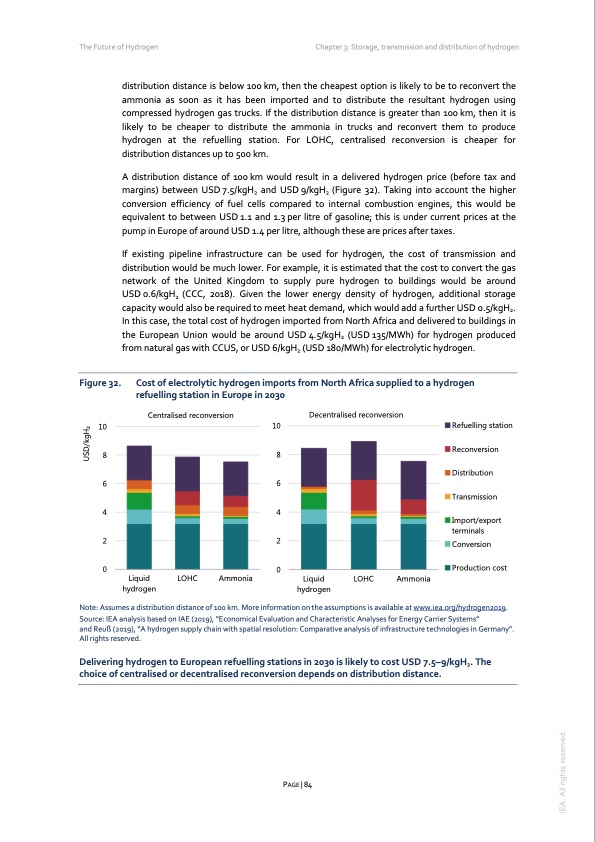
PDF Publication Title:
Text from PDF Page: 084
The Future of Hydrogen Chapter 3: Storage, transmission and distribution of hydrogen Figure 32. distribution distance is below 100 km, then the cheapest option is likely to be to reconvert the ammonia as soon as it has been imported and to distribute the resultant hydrogen using compressed hydrogen gas trucks. If the distribution distance is greater than 100 km, then it is likely to be cheaper to distribute the ammonia in trucks and reconvert them to produce hydrogen at the refuelling station. For LOHC, centralised reconversion is cheaper for distribution distances up to 500 km. A distribution distance of 100 km would result in a delivered hydrogen price (before tax and margins) between USD 7.5/kgH2 and USD 9/kgH2 (Figure 32). Taking into account the higher conversion efficiency of fuel cells compared to internal combustion engines, this would be equivalent to between USD 1.1 and 1.3 per litre of gasoline; this is under current prices at the pump in Europe of around USD 1.4 per litre, although these are prices after taxes. If existing pipeline infrastructure can be used for hydrogen, the cost of transmission and distribution would be much lower. For example, it is estimated that the cost to convert the gas network of the United Kingdom to supply pure hydrogen to buildings would be around USD 0.6/kgH2 (CCC, 2018). Given the lower energy density of hydrogen, additional storage capacity would also be required to meet heat demand, which would add a further USD 0.5/kgH2. In this case, the total cost of hydrogen imported from North Africa and delivered to buildings in the European Union would be around USD 4.5/kgH2 (USD 135/MWh) for hydrogen produced from natural gas with CCUS, or USD 6/kgH2 (USD 180/MWh) for electrolytic hydrogen. Cost of electrolytic hydrogen imports from North Africa supplied to a hydrogen refuelling station in Europe in 2030 10 Centralised reconversion Decentralised reconversion 10 88 66 44 22 00 Liquid LOHC Ammonia hydrogen Refuelling station Reconversion Distribution Transmission Import/export terminals Conversion Production cost Note: Assumes a distribution distance of 100 km. More information on the assumptions is available at www.iea.org/hydrogen2019. Source: IEA analysis based on IAE (2019), “Economical Evaluation and Characteristic Analyses for Energy Carrier Systems” and Reuß (2019), “A hydrogen supply chain with spatial resolution: Comparative analysis of infrastructure technologies in Germany”. All rights reserved. Delivering hydrogen to European refuelling stations in 2030 is likely to cost USD 7.5–9/kgH2. The choice of centralised or decentralised reconversion depends on distribution distance. Liquid hydrogen LOHC Ammonia PAGE | 84 IEA. All rights reserved. USD/kgH2PDF Image | The Future of Hydrogen 2019

PDF Search Title:
The Future of Hydrogen 2019Original File Name Searched:
the_future_of_hydrogen.pdfDIY PDF Search: Google It | Yahoo | Bing
NFT (Non Fungible Token): Buy our tech, design, development or system NFT and become part of our tech NFT network... More Info
IT XR Project Redstone NFT Available for Sale: NFT for high tech turbine design with one part 3D printed counter-rotating energy turbine. Be part of the future with this NFT. Can be bought and sold but only one design NFT exists. Royalties go to the developer (Infinity) to keep enhancing design and applications... More Info
Infinity Turbine IT XR Project Redstone Design: NFT for sale... NFT for high tech turbine design with one part 3D printed counter-rotating energy turbine. Includes all rights to this turbine design, including license for Fluid Handling Block I and II for the turbine assembly and housing. The NFT includes the blueprints (cad/cam), revenue streams, and all future development of the IT XR Project Redstone... More Info
Infinity Turbine ROT Radial Outflow Turbine 24 Design and Worldwide Rights: NFT for sale... NFT for the ROT 24 energy turbine. Be part of the future with this NFT. This design can be bought and sold but only one design NFT exists. You may manufacture the unit, or get the revenues from its sale from Infinity Turbine. Royalties go to the developer (Infinity) to keep enhancing design and applications... More Info
Infinity Supercritical CO2 10 Liter Extractor Design and Worldwide Rights: The Infinity Supercritical 10L CO2 extractor is for botanical oil extraction, which is rich in terpenes and can produce shelf ready full spectrum oil. With over 5 years of development, this industry leader mature extractor machine has been sold since 2015 and is part of many profitable businesses. The process can also be used for electrowinning, e-waste recycling, and lithium battery recycling, gold mining electronic wastes, precious metals. CO2 can also be used in a reverse fuel cell with nafion to make a gas-to-liquids fuel, such as methanol, ethanol and butanol or ethylene. Supercritical CO2 has also been used for treating nafion to make it more effective catalyst. This NFT is for the purchase of worldwide rights which includes the design. More Info
NFT (Non Fungible Token): Buy our tech, design, development or system NFT and become part of our tech NFT network... More Info
Infinity Turbine Products: Special for this month, any plans are $10,000 for complete Cad/Cam blueprints. License is for one build. Try before you buy a production license. May pay by Bitcoin or other Crypto. Products Page... More Info
| CONTACT TEL: 608-238-6001 Email: greg@infinityturbine.com | RSS | AMP |